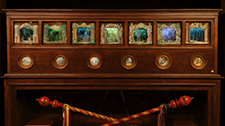Entertainment Hall. Collection of paper theatres: Engelbrecht dioramas (Hall 17)

These dioramas are considered the precursors to 19th century paper theatres, of which there are many examples in this gallery. There are paper theatres from Germany, France and Spain, which include those published by Paluzie. This is a very good collection. These pieces are on display in showcases that have been specially made to ensure optimal viewing.
Paper theatres were quite popular throughout Europe in the 19th century. They are a good example of the way in which children's games employed the imagination of each child while providing a cultural lesson as well.
The most outstanding pieces in this collection are the Engelbrecht dioramas, which take their name from the German engraver who created them. In 1719 he received imperial privilege, which gave him an exclusive patent for the creation of these tiny theatres and leading to their extreme popularity. These wonderful pieces later became objects of desire for many collectors. Ever faithful to his instinct and great sensitivity, Frederic Marès managed to collect seven dioramas from the various series published by Engelbrecht. You can view them in the glass showcase located to the right of the velocipedes. The following scenes are represented: a piece featuring courtesans, Paradise, the Wedding at Cana, theMassacre of the Innocents in Bethlehem, the Flagellation of Christ, Noah's Ark and theCrucifixion. These prints are etchings which have been tinted using watercolors. The pictures were then cut out and mounted on paper wings reinforced by cardboard, which simulated the scenery and backdrops of a real theatre.
This brings us to the end of our museum tour. We hope you have enjoyed your visit and trust that we will see you again soon.


